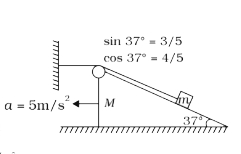In the figure shown the acceleration of A is, ¯aA=(15ˆi+15ˆj)m/s2. If A is sliding on B then the acceleration of B is.
 Solution in Gujrati
Solution in Gujrati
6ˆi
−15ˆi
10ˆi
−5ˆi
The correct Answer is:D
Let acceleration of B →aB=aBˆi
Then acceleration of A w.r.t.
B=→aA−→aR=(15−aB)ˆi+15ˆj
This acceleration must be along the inclined pplane
so tan37∘=1515−aB⇒34=1515−aBaB=−5
⇒→aR=−5ˆi
Topper's Solved these Questions
- KINEMATICSBOOK - ALLEN CHAPTER - KINEMATICSEXERCISE - EXERCISE-03
6 Videos
- KINEMATICSBOOK - ALLEN CHAPTER - KINEMATICSEXERCISE - Assertion-Reason
20 Videos
- KINEMATICSBOOK - ALLEN CHAPTER - KINEMATICSEXERCISE - EXERCISE-01
55 Videos
- ERROR AND MEASUREMENTBOOK - ALLEN CHAPTER - ERROR AND MEASUREMENTEXERCISE - Part-2(Exercise-2)(B)
22 Videos
- KINEMATICS (MOTION ALONG A STRAIGHT LINE AND MOTION IN A PLANE)BOOK - ALLEN CHAPTER - KINEMATICS (MOTION ALONG A STRAIGHT LINE AND MOTION IN A PLANE)EXERCISE - BEGINNER S BOX-7
8 Videos
Similar Questions
The equation of one dimensional motion of the particle is described in column I. At t=0, particle is at origin and at rest. Match the column I with the statement in Column II.
Column IColumn II(A)x=(3t2+2)m(p)Velocity of particle at t=1s is 8m/s(B)v=8tm/s(q)Particle moves with uniform acceleration(C)a=16t(r)Particle moves with variable acceleration(D)v=6t−3t2(s)Particle will change its direction some time
View SolutionAssertion: A projectile is thrown with an initial velocity of (aˆi+bˆj)m/sec. If range of projectile is maximum then a=b.
Reason: In projectile motion, angle of projection is equal to 45∘ for maximum rang econdition.
View SolutionA bird moves from point (1,−2,3) to (4,2,3). If the speed of the bird id 10m/s, then the velocity of the bird is :-
View SolutionA cube has a side of length 1.2×10−2m. Calculate its volume.
View SolutionA football player kicks a ball at an angle of 30∘ with an initial speed of 20 m/s. Assuming that the ball travels in a vertical plane, calculate (a) the time at which the ball reaches the highest point (b) the maximum height reached (c) the horizontal range of the ball (d) the time for which the ball is in the air, (g=10m/s2)
View SolutionIn the figure acceleration of A is 1m/s2 upward, acceleration of B is 7m/s2 upward acceleration of C is 2m/s2 upward. The acceleration of D will be.

View SolutionPoint A on the rod AB has an acceleration of 5m//s^(2) and a velocity of 6m//s at an instant as shown in the figure. The acceleration of the end B at the same moment is:
View SolutionIf acceleration of block B is 4m/s2 upward & that of C is 6m/s2 downward. Find acceleration of A :−

View SolutionIn the figure find the velocity and acceleration of B, if instaneous velocity and acceleration of A are as shown in the Fig.
View SolutionBlock C shown in figure-1.79 is going down at acceleration 2 m//s^(2) . Find the acceleration of blocks A and B.
View SolutionIn the figure shown the acceleration of A is, bara_(A)=(15hati+15hatj)m//s^(2). If A is sliding on B then the acceleration of B is.
View SolutionIn the arrangement shown in figure, if the acceleration of B is overline(a) , then find the acceleration of A
View SolutionAs shown in the figure, if acceleration of M with respect to ground is 5m/s2, then :

View SolutionIn the arrangement shown, the magnitude of acceleration of C (in m/ s^(2) ) if A and B have acceleration as shown is ________.
View SolutionIn the figure shown the acceleration of A is, veca =15hati+15hatj then the acceleration of B is: (A remains in contact with B)
View SolutionA का बायी ओर त्वरण 2m/s2 है एवं B का बायी ओर त्वरण 1m/s2 है। C का त्वरण होगा

View Solution
